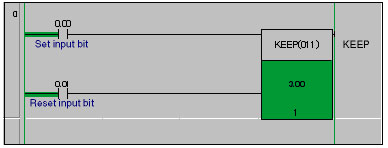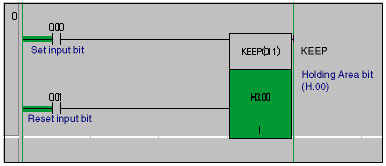What is the difference between a Holding Area bit and a keep bit or a KEEP instruction?
With a SYSMAC Programmable Controllers, a Holding Area bit is a type of bit. There is no such bit as a keep bit. The correct term is the operand bit for a KEEP instruction. First, let's look at the KEEP instruction.
Figure 1
Basic Functions of the KEEP Instruction
In Figure 1, when the set input bit (CIO 0.00) is input as a pulse signal as shown in Figure 2, the output bit (CIO 3.00) specified for the operand of the KEEP instruction will remain ON until reset input bit (CIO 0.01) turns ON. By using the KEEP instruction in this way, even after the input signal turns OFF, the output bit status can be preserved in the state it was before the input signal turned OFF.
Figure 2
CIO000000: Set input bit (CIO 0.00)
CIO000001: Reset input bit (CIO 0.01)
CIO000300: Output bit (CIO 3.00)
Function of a Holding Area Bit
What happens if there is a power interruption while the output bit (CIO 3.00) shown in the time chart in Figure 2 is ON? If this happens, all of the output bits will be reset when power resumes. If you want to preserve the ON or OFF status for a bit during a momentary or extended power interruption, you can use a Holding Area bit, as shown in Figure 3 (H3.00), as the bit controlled by the KEEP instruction.
Figure 3
Summary
1. With a SYSMAC Programmable Controllers, a Holding Area bit is a type of bit. There is no such bit as a keep bit. The correct term is the operand bit for a KEEP instruction.
2. By using a Holding Area bit with KEEP instructions, SET/RESET instructions, or programming that holds the status, such as for a self-holding bit, the status of the system immediately preceding a power interruption can be restored when power resumes.